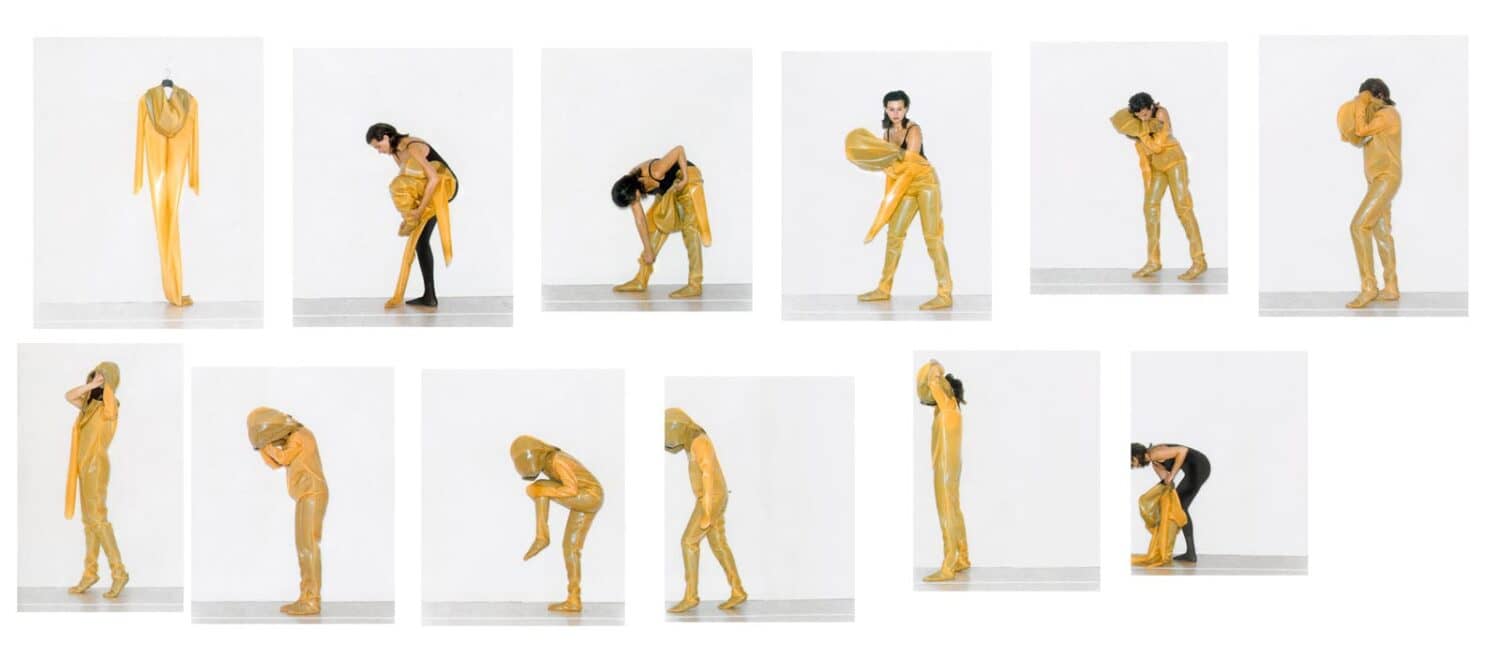OFF THE WALL, Performance for no audience, 2000 (video document)
The disorientations that permeate Margret Wibmer’s work can be perceived as a conscious extension of the process of perception through which the familiar body-space experience is invalidated. The artist initially took her own body as her starting point. Performance for no audience (1998) can be seen as a ‘prototype’ of those works, in which Margret Wibmer uses her body as a ‘material’, a photographic series in which she wears a yellow rubber suit. The body becomes a sculpture and the suit becomes a second skin, a medial surface, an interface. According to Reinhard Braun’s analysis in 2000, Margret Wibmer’s interest revolved around Schnittstellen (interfaces), between bodies, their surfaces and their interaction with the space, through glances and sound, and not least through cultural systems of symbols.
Ludwig Seyfarth

About OFF THE WALL
When you open the black curtains to enter the exhibition space you see a large projection of a figure difficult to identify. She is moving and you hear sound. It takes some time before you realize that this is a moving body. Only after some time one realizes that the projected figure changes and moves as you walk through the space. This is a fascinating aspect and creates a pleasant uncertainty. Off the Wall is a collaboration between Margret Wibmer and Günther Zechberger. Off the Wall has qualities which create interest to find out about the making of it and it’s meaning.
Fabrics and clothing
Off the Wall is an outstanding work of art in the context of Margret Wibmer’s work. It is a large project, which on the one hand is a continuation of her earlier work and on the other is an exception involving complex technical processes. One of the key elements in Margret Wibmer’s work is her interest in fabrics and clothing. She creates three-dimensional objects, which refer to the body. Some of her objects suggest the presence of a living body in the room. Others make us more aware of our own physical condition and our living presence in the space. For Off the Wall, she created a special rubber suit, which she herself stepped into and inhabited in the video.
Off the Wall is constructed from video images of an unrecognizable Margret Wibmer who creates different gestural poses. The strange nature of the thick and stiff rubber makes one realize immediately you are seeing a living figure and not an animation. The image stimulates our sense of touch. The original video images were translated into Quick Time objects, which gives us the impression of a changing series of photographs and details of photographs.
‘The disorientation of the eye’
Off the Wall was part of the exhibition ‘The Disorientation of the Eye’, which took place in March/April 2000 at the Beyerd in Breda, the Netherlands. This exhibition was curated by Margret Wibmer investigating how images create a different meaning today than in the past.
An act of resistance
Wibmer wants the viewer to get involved with the figure. Introducing an artwork, which suggests a physical presence to the world of electronic media, can be seen in itself as an act of resistance. Her images are different from other electronic images because she manages to create the illusion of a physically present human body regardless of all digital transformations.
More than just a symbol
Most of Wibmer’s works made prior to Off the Wall are wall sculptures, which call on physical experiences due to their material quality and shape. She is using materials, which are elastic and flexible. A thin and mat plastic is combined with a red stretch terry cloth. The plastic is neither flexible nor soft but takes on that appearance due to the shape she creates and the combination she makes with the flexible quality of the terry cloth. The red fabric is not heavy enough to stretch the plastic but the suggestion is created.
One could say that Wibmer’s works are building upon concepts which were developed by Louise Bourgeois and Maria Lassnig during the course of the 20th Century. Margret Wibmer’s sculptures interpret a similar interest in the physical presence of a body. Another similarity between the work of Wibmer, Bourgeois and Lassnig is based on the vulnerability of the works.
Wibmer’s sculptures are never thoroughly finished off. In the same way as a sketch or drawing, the finishing appears arbitrary. With an improvisational feel, it seems put down by accident like an ephemeral thought. This way of working calls upon a form of aesthetics which opposes and disassociates itself from the images produced by the mass media for commercial purposes. They escape simple recognition.
Protective clothing
A more profound interpretation of her working process however is related to the perception of reality. When we think about today’s society this question plays an important role. Theorists and artists are investigating the question – to what extent the reproduction of the image and the electronic transfer of images is influencing our perception of reality.
Coming from a very personal motivation – the physical presence, Wibmer draws on a universal theme: shelter and protection. Her current works are little packages from folded fabrics and non-woven materials. These bundles resemble rescue packages which cannot be unfolded. The effect is both imaginative and suggestive.
Saskia Monshouwer
OFF THE WALL, 2000. Interactive Virtual Reality Opera by visual artist Margret Wibmer and composer Günther Zechberger.
Technical team: Rens Veltman – construction of robot for QuickTime VR recording / Tommi Bergmann – image and sound control / Heiko Lochas – motion tracking/mathematical operations / Daniel Fischer – motion tracking
Photographs by Julian Broad, 2000 published in Sony Style Magazine
Ludwig Seyfarth Relax your hips (excerpt) – ‘Margret Wibmer and irritants between bodies, things and spaces’ , published in Margret Wibmer – ambiguity, bodies, objects and spaces, Kerber Verlag, 2010
Saskia Monshouwer, text published in ‘GREYT’ magazine,The Netherlands; Jan/Feb 2001. English translation: Patricia Bardi (the English translation is a summary of the original Dutch text).
